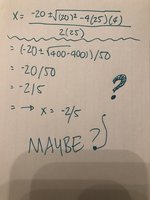You are using an out of date browser. It may not display this or other websites correctly.
You should upgrade or use an alternative browser.
You should upgrade or use an alternative browser.
Order of Operations w/sqrt
- Thread starter Devinne
- Start date
lev888
Elite Member
- Joined
- Jan 16, 2018
- Messages
- 2,993
Looks correct. It appears to be the formula for the roots of a quadratic equation. In general there are 2 solutions - one for "+" and one for "-" in "+/-". In this case you have one root since the expression under the square root (discriminant) is 0.
Read this: https://en.wikipedia.org/wiki/Quadratic_equation
Read this: https://en.wikipedia.org/wiki/Quadratic_equation
The \(\pm\) symbol is there to remind you that quadratics have two roots (not necessarily real roots mind you, and they might be the same), so you'd want to craft two equations to find those roots - one with \(+\) and the other with \(-\):
\(\displaystyle x_1 = \frac{-20 \: {\color{red} \mathbf{+}} \: \sqrt{20^2 - 4(25)(4)}}{2(25)}\)
\(\displaystyle x_2 = \frac{-20 \: {\color{red} \mathbf{-}} \: \sqrt{20^2 - 4(25)(4)}}{2(25)}\)
\(\displaystyle x_1 = \frac{-20 \: {\color{red} \mathbf{+}} \: \sqrt{20^2 - 4(25)(4)}}{2(25)}\)
\(\displaystyle x_2 = \frac{-20 \: {\color{red} \mathbf{-}} \: \sqrt{20^2 - 4(25)(4)}}{2(25)}\)
D
Deleted member 4993
Guest
In general you'll have two solutions due to that ± sign.Looking for step by step...
am stuck on the +/- symbol and the sqrt but having difficulty with whole problem..
Thank you so much...
In this particular case, however, the expression under the radical (√) is equal to zero.
Thus you will have only one solution. You have "repeated" roots for your function. You correctly calculated the value of 'x'.
The simple rules about real roots of polynomials with real coefficients of degree n are:
(1) The number of real roots cannot exceed n;
(2) If n is odd, there is at least one real root; and
(3) If n is even, there may be no real roots.
If we apply those rules to a quadratic, a polynomial of degree 2, we find that it may have no real root, 1 real root, or 2 distinct real roots. How do you know which of those situations apply to a specific case?
You look at the discriminant of the quadratic.
[MATH]b^2 - 4ac < 0 \implies 0 \text { real roots;}[/MATH]
[MATH]b^2 - 4ac = 0 \implies 1 \text { real root; and}[/MATH]
[MATH]b^2 - 4ac > 0 \implies 2 \text { distinct real roots.}[/MATH]
For reasons that make sense, some people prefer to say that a quadratic always has two roots, but it may have no real roots, and if it has real roots, they may be duplicates. I prefer my way because it relates the three possible signs of the discriminant to three possible numbers of distinct, real roots. Just remember whichever seems more intuitive to you.
In any case, good job.
(1) The number of real roots cannot exceed n;
(2) If n is odd, there is at least one real root; and
(3) If n is even, there may be no real roots.
If we apply those rules to a quadratic, a polynomial of degree 2, we find that it may have no real root, 1 real root, or 2 distinct real roots. How do you know which of those situations apply to a specific case?
You look at the discriminant of the quadratic.
[MATH]b^2 - 4ac < 0 \implies 0 \text { real roots;}[/MATH]
[MATH]b^2 - 4ac = 0 \implies 1 \text { real root; and}[/MATH]
[MATH]b^2 - 4ac > 0 \implies 2 \text { distinct real roots.}[/MATH]
For reasons that make sense, some people prefer to say that a quadratic always has two roots, but it may have no real roots, and if it has real roots, they may be duplicates. I prefer my way because it relates the three possible signs of the discriminant to three possible numbers of distinct, real roots. Just remember whichever seems more intuitive to you.
In any case, good job.
Last edited:


